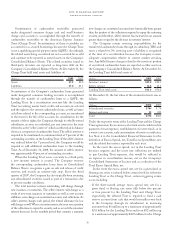American Express 2008 Annual Report Download - page 46
Download and view the complete annual report
Please find page 46 of the 2008 American Express annual report below. You can navigate through the pages in the report by either clicking on the pages listed below, or by using the keyword search tool below to find specific information within the annual report.2008 financial review
american express company
consumer credit risk
Consumer credit risk arises principally from consumer and
small business charge cards, credit cards, lines of credit, and
loans. These portfolios consist of millions of borrowers across
multiple geographies, occupations, industries and levels of
net worth. The Company benefits from the attractive profile
of its cardmembers, which is driven by brand positioning,
underwriting, and customer management policies, premium
customer servicing, and product reward features. The risk in
these portfolios is correlated with broad economic trends, such
as unemployment rates and home values, which can have a
material affect on credit performance.
General principles and the overall framework for managing
consumer credit risk across the Company are defined in the
Individual Credit Risk Policy approved by the ERMC. This
policy is further supported by subordinate policies and practices
covering all facets of consumer credit extension, including
prospecting, approvals, authorizations, line management,
collections, and fraud prevention. These policies ensure
consistent application of credit management principles and
standardized reporting of asset quality and loss recognition.
Consumer credit risk management is supported by
sophisticated proprietary scoring and decision-making models
that use the most up-to-date proprietary information on
customers, such as spending and payment history, data feeds from
credit bureaus, and mortgage information. The Company has
developed unique decision logic for each customer interaction,
including prospect targeting, new account approvals, line
assignment, balance transfers, cross selling and overall account
management and collection.
institutional credit risk
Institutional credit risk arises principally within the Company’s
corporate card services, merchant services, network services, and
from the Company’s investment activities. Unlike consumer
credit risk, institutional credit risk is characterized by a lower
loss frequency but higher severity. It is affected both by general
economic conditions and by borrower-specific events. The
Company’s senior risk officers recognize that the absence of large
losses in any given year or over several years is not necessarily
representative of the risk of institutional portfolios, given the
infrequency of loss events in such portfolios.
General principles and the overall framework for managing
institutional credit risk across the Company are defined in
the Institutional Credit Risk Policy approved by the ERMC.
The Institutional Risk Management Committee (IRMC) is
responsible for implementation and enforcement of this policy
and for providing guidance to the credit officers of each business
unit with substantial institutional credit risk exposures, who in
turn make investment decisions in core risk capabilities, ensure
proper implementation of the underwriting standards and
contractual rights of risk mitigation, monitor risk exposures,
and determine risk mitigation actions. The IRMC formally
reviews large institutional exposures to ensure compliance
with ERMC guidelines and procedures and escalates them
to the ERMC as appropriate. At the same time, the IRMC
provides continuous guidance to business unit risk teams to
optimize risk-adjusted returns on capital. A company-wide risk
rating utility and a specialized airline risk group provide risk
assessment of institutional obligors.
market risk management process
Market risk is the risk to earnings or value resulting from
movements in market prices. The Company’s market risk
exposure is primarily generated by:
• Interest rate risk in its card, insurance, and certificate
businesses; and
• Foreign exchange risk in its international operations.
General principles and the overall framework for managing
market risk across the Company are defined in the Market Risk
Policy approved by the ERMC. Market risk is centrally managed
by the Market Risk Committee, chaired by the Chief Market
Risk Officer of the Company. Within each business, market
risk exposures are monitored and managed by various asset/
liability committees, guided by Board-approved policies covering
derivative financial instruments, funding and investments.
Derivative financial instruments derive their value from an
underlying variable or multiple variables, including interest rate,
foreign exchange, and equity indices or prices. These instruments
enable end users to increase, reduce or alter exposure to various
market risks and, for that reason, are an integral component of the
Company’s market risk and related asset/liability management
strategy and processes. Use of derivative financial instruments is
incorporated into the discussion below as well as Note 14.
Market exposure is a byproduct of the delivery of products
and services to cardmembers. Interest rate risk is primarily
generated by funding cardmember charges and fixed-rate
loans with variable rate borrowings. These assets and liabilities
generally do not create naturally offsetting positions with
respect to basis, re-pricing, or maturity characteristics.
For the Company’s charge card and fixed-rate lending
products, interest rate exposure is managed by shifting the
mix of funding toward fixed-rate debt and by using derivative
instruments, with an emphasis on interest rate swaps, which
effectively fix interest expense for the length of the swap. The
Company may change the amount hedged and the hedge
percentage may change based on changes in business volumes
and mix, among other factors. For the majority of its cardmember
loans, which are linked to a floating rate base and generally
reprice each month, the Company uses floating rate funding.
The Company regularly reviews its strategy and may modify
44
























